BA30592E Recording Business Transactions - University of West London
VerifiedAdded on 2023/04/06
|16
|2195
|182
Practical Assignment
AI Summary
This assignment provides a detailed solution to a practical accounting problem involving the recording of business transactions for Mel, who commences trading on October 1, 2018. The solution includes journal entries for September 2019, T-accounts, a trial balance, an income statement, and a balance sheet. Additionally, the assignment includes a ratio analysis of Mel's financial performance, covering key metrics such as net profit margin, gross profit margin, current ratio, acid test ratio, accounts receivable turnover, and accounts payable payment period. Finally, a financial analysis of Jill’s company is conducted, comparing its performance against competitors, focusing on net profit margin, gross profit margin, current ratio, acid test ratio, accounts receivable collection period, and accounts payable payment period. This document is available on Desklib, a platform offering a range of study tools and solved assignments for students.
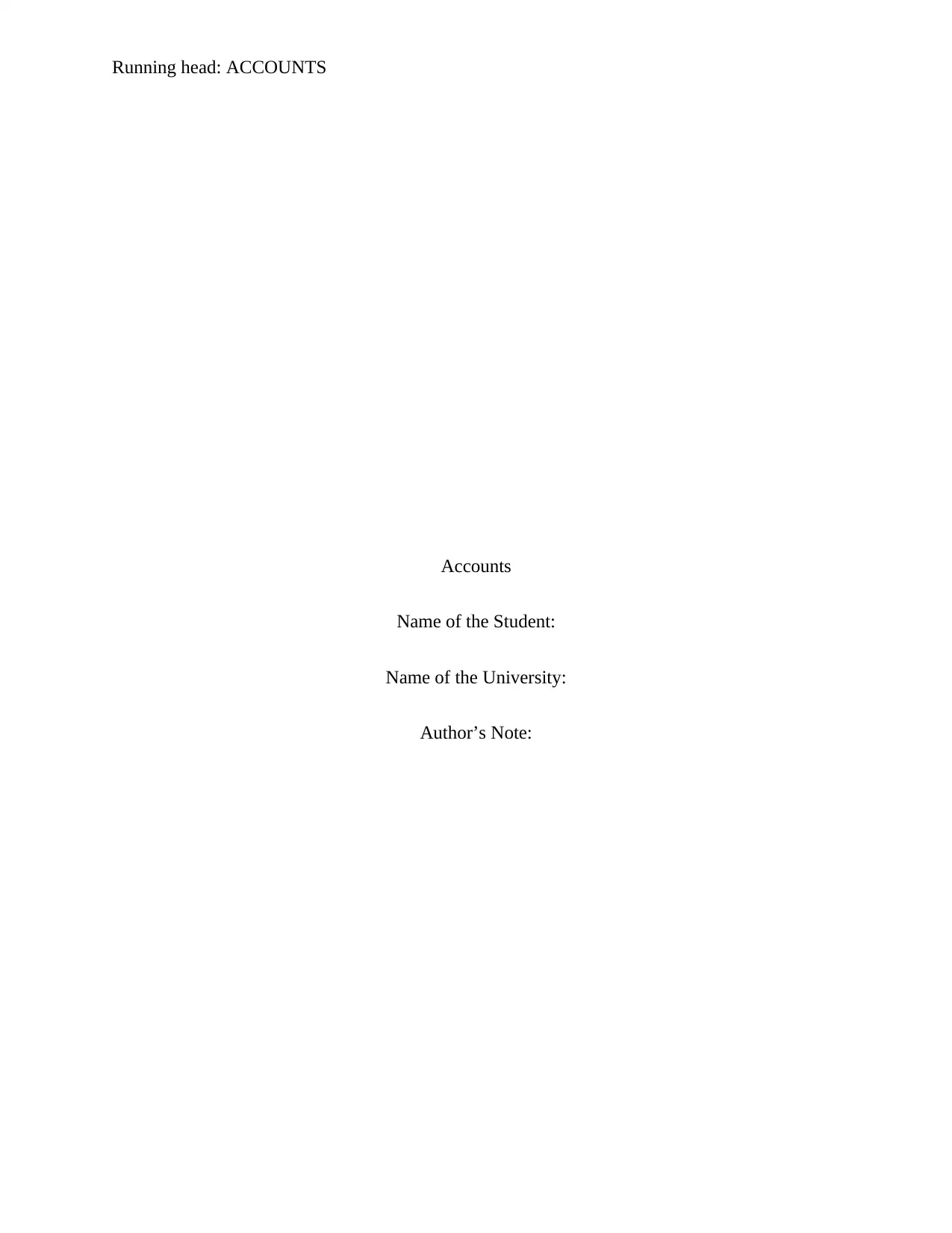
Running head: ACCOUNTS
Accounts
Name of the Student:
Name of the University:
Author’s Note:
Accounts
Name of the Student:
Name of the University:
Author’s Note:
Paraphrase This Document
Need a fresh take? Get an instant paraphrase of this document with our AI Paraphraser

1ACCOUNTS
Table of Contents
Part A...............................................................................................................................................2
Requirement A.............................................................................................................................2
Requirement B.............................................................................................................................4
Requirement C.............................................................................................................................7
Requirement D.............................................................................................................................8
Requirement E.............................................................................................................................9
Part B.............................................................................................................................................10
Part C.............................................................................................................................................11
Bibliography..................................................................................................................................14
Table of Contents
Part A...............................................................................................................................................2
Requirement A.............................................................................................................................2
Requirement B.............................................................................................................................4
Requirement C.............................................................................................................................7
Requirement D.............................................................................................................................8
Requirement E.............................................................................................................................9
Part B.............................................................................................................................................10
Part C.............................................................................................................................................11
Bibliography..................................................................................................................................14
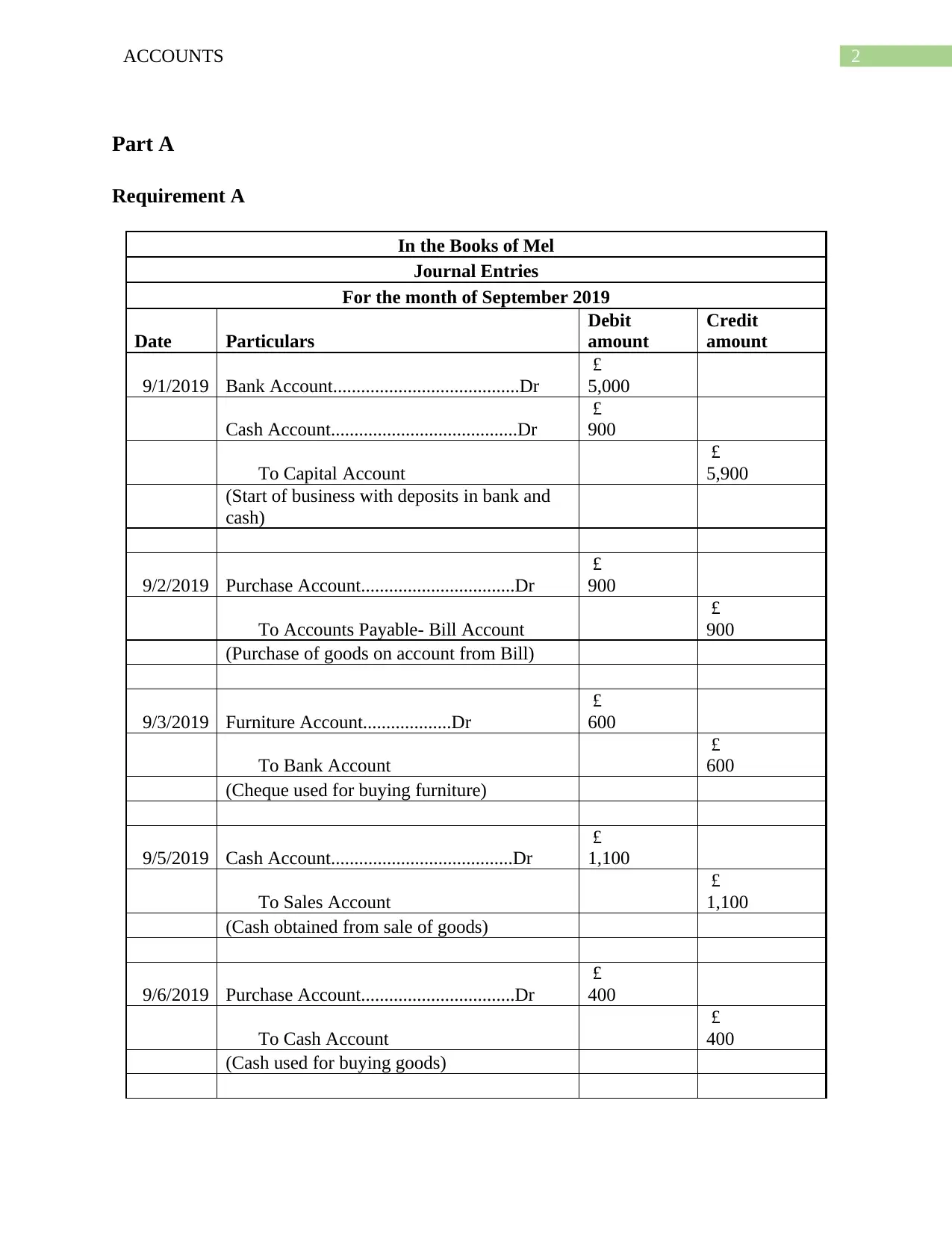
2ACCOUNTS
Part A
Requirement A
In the Books of Mel
Journal Entries
For the month of September 2019
Date Particulars
Debit
amount
Credit
amount
9/1/2019 Bank Account........................................Dr
£
5,000
Cash Account........................................Dr
£
900
To Capital Account
£
5,900
(Start of business with deposits in bank and
cash)
9/2/2019 Purchase Account.................................Dr
£
900
To Accounts Payable- Bill Account
£
900
(Purchase of goods on account from Bill)
9/3/2019 Furniture Account...................Dr
£
600
To Bank Account
£
600
(Cheque used for buying furniture)
9/5/2019 Cash Account.......................................Dr
£
1,100
To Sales Account
£
1,100
(Cash obtained from sale of goods)
9/6/2019 Purchase Account.................................Dr
£
400
To Cash Account
£
400
(Cash used for buying goods)
Part A
Requirement A
In the Books of Mel
Journal Entries
For the month of September 2019
Date Particulars
Debit
amount
Credit
amount
9/1/2019 Bank Account........................................Dr
£
5,000
Cash Account........................................Dr
£
900
To Capital Account
£
5,900
(Start of business with deposits in bank and
cash)
9/2/2019 Purchase Account.................................Dr
£
900
To Accounts Payable- Bill Account
£
900
(Purchase of goods on account from Bill)
9/3/2019 Furniture Account...................Dr
£
600
To Bank Account
£
600
(Cheque used for buying furniture)
9/5/2019 Cash Account.......................................Dr
£
1,100
To Sales Account
£
1,100
(Cash obtained from sale of goods)
9/6/2019 Purchase Account.................................Dr
£
400
To Cash Account
£
400
(Cash used for buying goods)
⊘ This is a preview!⊘
Do you want full access?
Subscribe today to unlock all pages.

Trusted by 1+ million students worldwide
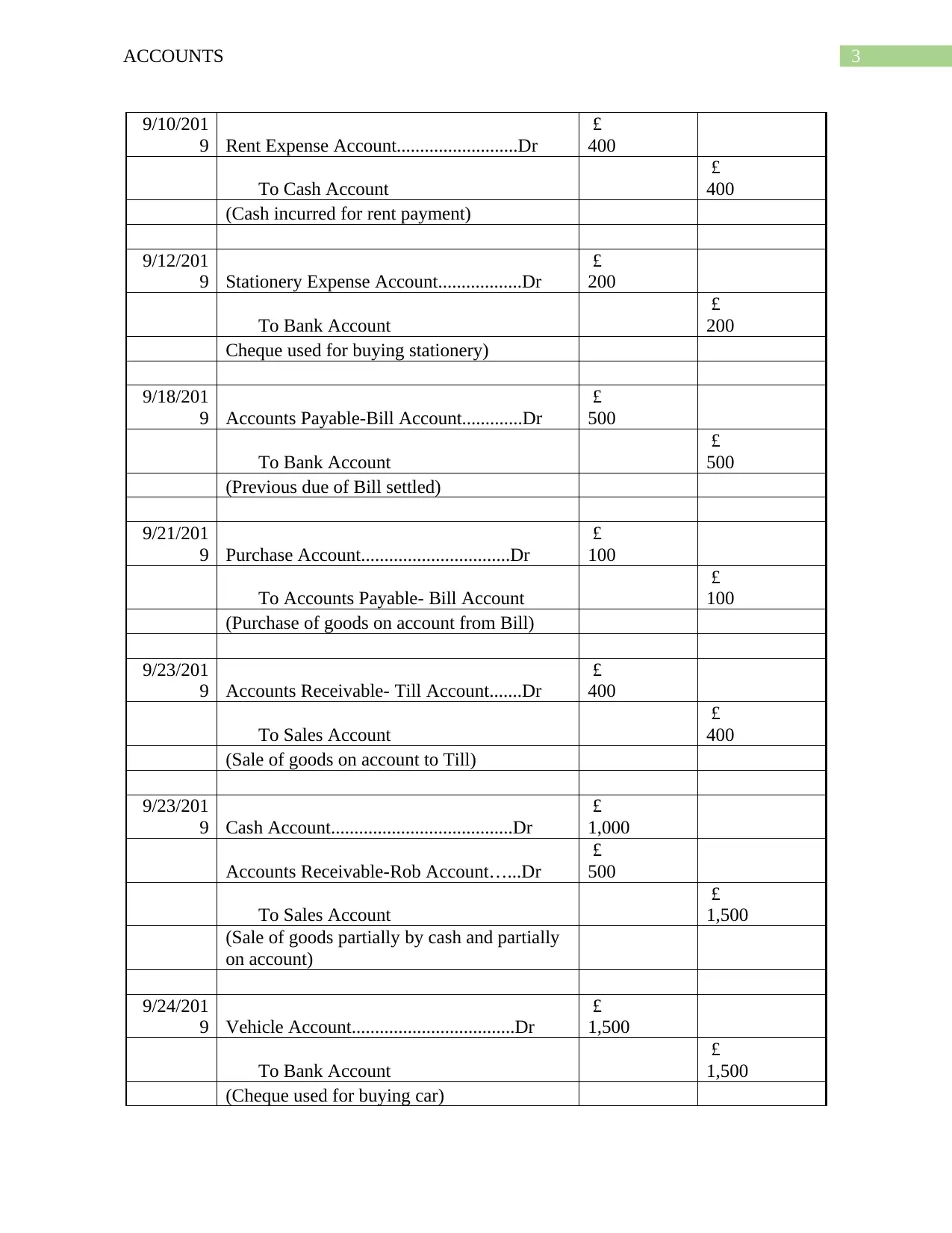
3ACCOUNTS
9/10/201
9 Rent Expense Account..........................Dr
£
400
To Cash Account
£
400
(Cash incurred for rent payment)
9/12/201
9 Stationery Expense Account..................Dr
£
200
To Bank Account
£
200
Cheque used for buying stationery)
9/18/201
9 Accounts Payable-Bill Account.............Dr
£
500
To Bank Account
£
500
(Previous due of Bill settled)
9/21/201
9 Purchase Account................................Dr
£
100
To Accounts Payable- Bill Account
£
100
(Purchase of goods on account from Bill)
9/23/201
9 Accounts Receivable- Till Account.......Dr
£
400
To Sales Account
£
400
(Sale of goods on account to Till)
9/23/201
9 Cash Account.......................................Dr
£
1,000
Accounts Receivable-Rob Account…...Dr
£
500
To Sales Account
£
1,500
(Sale of goods partially by cash and partially
on account)
9/24/201
9 Vehicle Account...................................Dr
£
1,500
To Bank Account
£
1,500
(Cheque used for buying car)
9/10/201
9 Rent Expense Account..........................Dr
£
400
To Cash Account
£
400
(Cash incurred for rent payment)
9/12/201
9 Stationery Expense Account..................Dr
£
200
To Bank Account
£
200
Cheque used for buying stationery)
9/18/201
9 Accounts Payable-Bill Account.............Dr
£
500
To Bank Account
£
500
(Previous due of Bill settled)
9/21/201
9 Purchase Account................................Dr
£
100
To Accounts Payable- Bill Account
£
100
(Purchase of goods on account from Bill)
9/23/201
9 Accounts Receivable- Till Account.......Dr
£
400
To Sales Account
£
400
(Sale of goods on account to Till)
9/23/201
9 Cash Account.......................................Dr
£
1,000
Accounts Receivable-Rob Account…...Dr
£
500
To Sales Account
£
1,500
(Sale of goods partially by cash and partially
on account)
9/24/201
9 Vehicle Account...................................Dr
£
1,500
To Bank Account
£
1,500
(Cheque used for buying car)
Paraphrase This Document
Need a fresh take? Get an instant paraphrase of this document with our AI Paraphraser
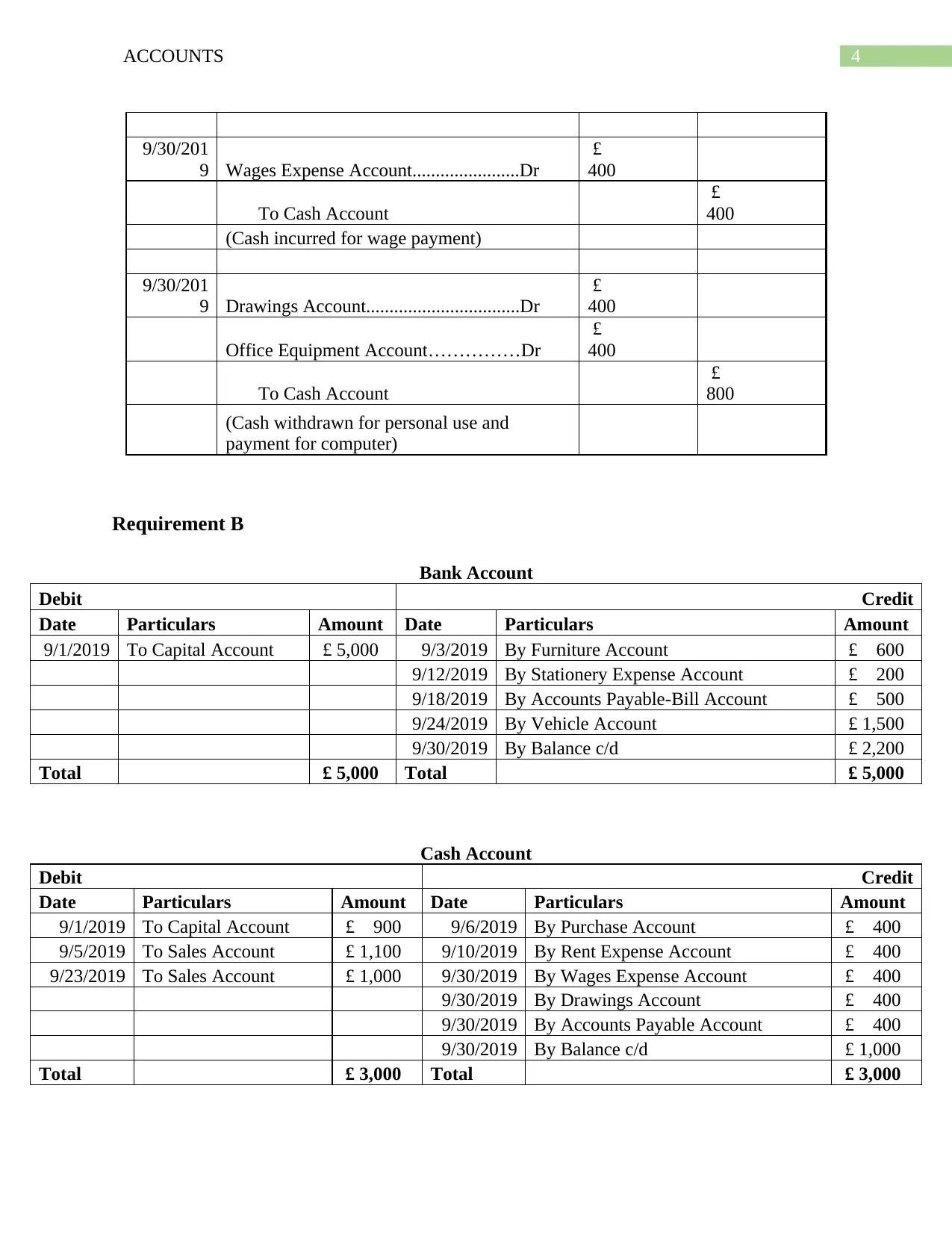
4ACCOUNTS
9/30/201
9 Wages Expense Account.......................Dr
£
400
To Cash Account
£
400
(Cash incurred for wage payment)
9/30/201
9 Drawings Account.................................Dr
£
400
Office Equipment Account……………Dr
£
400
To Cash Account
£
800
(Cash withdrawn for personal use and
payment for computer)
Requirement B
Bank Account
Debit Credit
Date Particulars Amount Date Particulars Amount
9/1/2019 To Capital Account £ 5,000 9/3/2019 By Furniture Account £ 600
9/12/2019 By Stationery Expense Account £ 200
9/18/2019 By Accounts Payable-Bill Account £ 500
9/24/2019 By Vehicle Account £ 1,500
9/30/2019 By Balance c/d £ 2,200
Total £ 5,000 Total £ 5,000
Cash Account
Debit Credit
Date Particulars Amount Date Particulars Amount
9/1/2019 To Capital Account £ 900 9/6/2019 By Purchase Account £ 400
9/5/2019 To Sales Account £ 1,100 9/10/2019 By Rent Expense Account £ 400
9/23/2019 To Sales Account £ 1,000 9/30/2019 By Wages Expense Account £ 400
9/30/2019 By Drawings Account £ 400
9/30/2019 By Accounts Payable Account £ 400
9/30/2019 By Balance c/d £ 1,000
Total £ 3,000 Total £ 3,000
9/30/201
9 Wages Expense Account.......................Dr
£
400
To Cash Account
£
400
(Cash incurred for wage payment)
9/30/201
9 Drawings Account.................................Dr
£
400
Office Equipment Account……………Dr
£
400
To Cash Account
£
800
(Cash withdrawn for personal use and
payment for computer)
Requirement B
Bank Account
Debit Credit
Date Particulars Amount Date Particulars Amount
9/1/2019 To Capital Account £ 5,000 9/3/2019 By Furniture Account £ 600
9/12/2019 By Stationery Expense Account £ 200
9/18/2019 By Accounts Payable-Bill Account £ 500
9/24/2019 By Vehicle Account £ 1,500
9/30/2019 By Balance c/d £ 2,200
Total £ 5,000 Total £ 5,000
Cash Account
Debit Credit
Date Particulars Amount Date Particulars Amount
9/1/2019 To Capital Account £ 900 9/6/2019 By Purchase Account £ 400
9/5/2019 To Sales Account £ 1,100 9/10/2019 By Rent Expense Account £ 400
9/23/2019 To Sales Account £ 1,000 9/30/2019 By Wages Expense Account £ 400
9/30/2019 By Drawings Account £ 400
9/30/2019 By Accounts Payable Account £ 400
9/30/2019 By Balance c/d £ 1,000
Total £ 3,000 Total £ 3,000
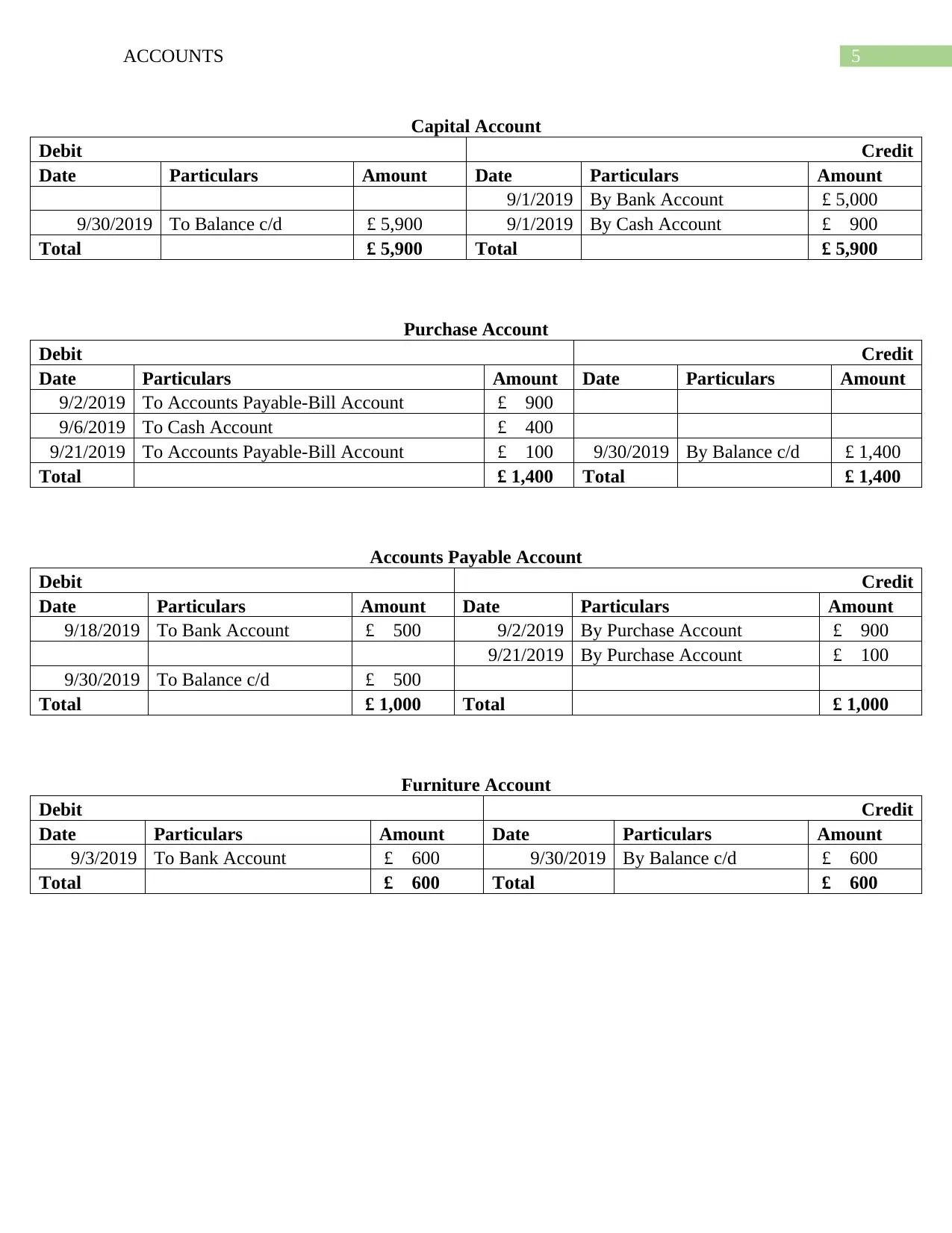
5ACCOUNTS
Capital Account
Debit Credit
Date Particulars Amount Date Particulars Amount
9/1/2019 By Bank Account £ 5,000
9/30/2019 To Balance c/d £ 5,900 9/1/2019 By Cash Account £ 900
Total £ 5,900 Total £ 5,900
Purchase Account
Debit Credit
Date Particulars Amount Date Particulars Amount
9/2/2019 To Accounts Payable-Bill Account £ 900
9/6/2019 To Cash Account £ 400
9/21/2019 To Accounts Payable-Bill Account £ 100 9/30/2019 By Balance c/d £ 1,400
Total £ 1,400 Total £ 1,400
Accounts Payable Account
Debit Credit
Date Particulars Amount Date Particulars Amount
9/18/2019 To Bank Account £ 500 9/2/2019 By Purchase Account £ 900
9/21/2019 By Purchase Account £ 100
9/30/2019 To Balance c/d £ 500
Total £ 1,000 Total £ 1,000
Furniture Account
Debit Credit
Date Particulars Amount Date Particulars Amount
9/3/2019 To Bank Account £ 600 9/30/2019 By Balance c/d £ 600
Total £ 600 Total £ 600
Capital Account
Debit Credit
Date Particulars Amount Date Particulars Amount
9/1/2019 By Bank Account £ 5,000
9/30/2019 To Balance c/d £ 5,900 9/1/2019 By Cash Account £ 900
Total £ 5,900 Total £ 5,900
Purchase Account
Debit Credit
Date Particulars Amount Date Particulars Amount
9/2/2019 To Accounts Payable-Bill Account £ 900
9/6/2019 To Cash Account £ 400
9/21/2019 To Accounts Payable-Bill Account £ 100 9/30/2019 By Balance c/d £ 1,400
Total £ 1,400 Total £ 1,400
Accounts Payable Account
Debit Credit
Date Particulars Amount Date Particulars Amount
9/18/2019 To Bank Account £ 500 9/2/2019 By Purchase Account £ 900
9/21/2019 By Purchase Account £ 100
9/30/2019 To Balance c/d £ 500
Total £ 1,000 Total £ 1,000
Furniture Account
Debit Credit
Date Particulars Amount Date Particulars Amount
9/3/2019 To Bank Account £ 600 9/30/2019 By Balance c/d £ 600
Total £ 600 Total £ 600
⊘ This is a preview!⊘
Do you want full access?
Subscribe today to unlock all pages.

Trusted by 1+ million students worldwide
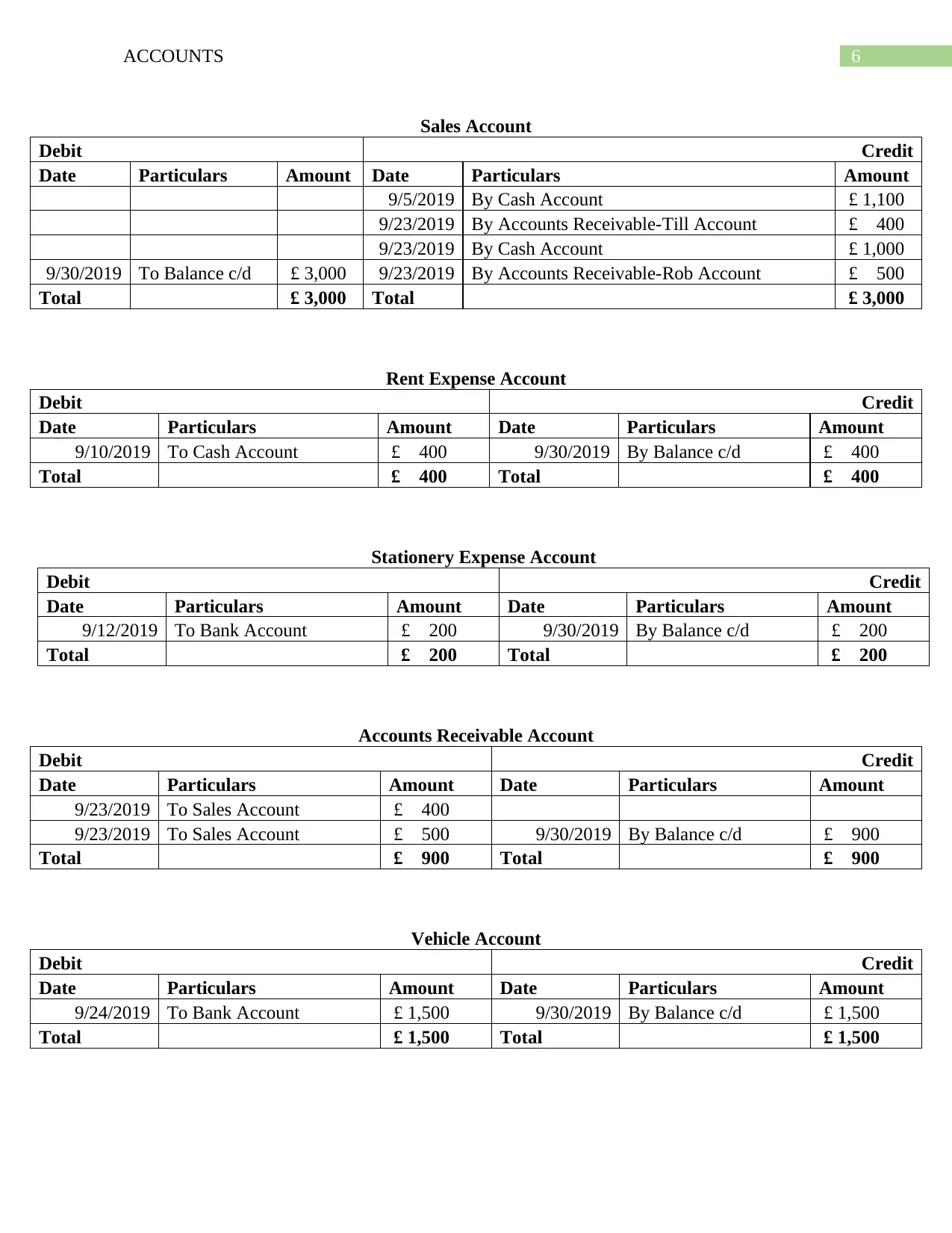
6ACCOUNTS
Sales Account
Debit Credit
Date Particulars Amount Date Particulars Amount
9/5/2019 By Cash Account £ 1,100
9/23/2019 By Accounts Receivable-Till Account £ 400
9/23/2019 By Cash Account £ 1,000
9/30/2019 To Balance c/d £ 3,000 9/23/2019 By Accounts Receivable-Rob Account £ 500
Total £ 3,000 Total £ 3,000
Rent Expense Account
Debit Credit
Date Particulars Amount Date Particulars Amount
9/10/2019 To Cash Account £ 400 9/30/2019 By Balance c/d £ 400
Total £ 400 Total £ 400
Stationery Expense Account
Debit Credit
Date Particulars Amount Date Particulars Amount
9/12/2019 To Bank Account £ 200 9/30/2019 By Balance c/d £ 200
Total £ 200 Total £ 200
Accounts Receivable Account
Debit Credit
Date Particulars Amount Date Particulars Amount
9/23/2019 To Sales Account £ 400
9/23/2019 To Sales Account £ 500 9/30/2019 By Balance c/d £ 900
Total £ 900 Total £ 900
Vehicle Account
Debit Credit
Date Particulars Amount Date Particulars Amount
9/24/2019 To Bank Account £ 1,500 9/30/2019 By Balance c/d £ 1,500
Total £ 1,500 Total £ 1,500
Sales Account
Debit Credit
Date Particulars Amount Date Particulars Amount
9/5/2019 By Cash Account £ 1,100
9/23/2019 By Accounts Receivable-Till Account £ 400
9/23/2019 By Cash Account £ 1,000
9/30/2019 To Balance c/d £ 3,000 9/23/2019 By Accounts Receivable-Rob Account £ 500
Total £ 3,000 Total £ 3,000
Rent Expense Account
Debit Credit
Date Particulars Amount Date Particulars Amount
9/10/2019 To Cash Account £ 400 9/30/2019 By Balance c/d £ 400
Total £ 400 Total £ 400
Stationery Expense Account
Debit Credit
Date Particulars Amount Date Particulars Amount
9/12/2019 To Bank Account £ 200 9/30/2019 By Balance c/d £ 200
Total £ 200 Total £ 200
Accounts Receivable Account
Debit Credit
Date Particulars Amount Date Particulars Amount
9/23/2019 To Sales Account £ 400
9/23/2019 To Sales Account £ 500 9/30/2019 By Balance c/d £ 900
Total £ 900 Total £ 900
Vehicle Account
Debit Credit
Date Particulars Amount Date Particulars Amount
9/24/2019 To Bank Account £ 1,500 9/30/2019 By Balance c/d £ 1,500
Total £ 1,500 Total £ 1,500
Paraphrase This Document
Need a fresh take? Get an instant paraphrase of this document with our AI Paraphraser

7ACCOUNTS
Wages Expense Account
Debit Credit
Date Particulars Amount Date Particulars Amount
9/30/2019 To Cash Account £ 400 9/30/2019 By Balance c/d £ 400
Total £ 400 Total £ 400
Drawings Account
Debit Credit
Date Particulars Amount Date Particulars Amount
9/30/2019 To Cash Account £ 400 9/30/2019 By Balance c/d £ 400
Total £ 400 Total £ 400
Office Equipment Account
Debit Credit
Date Particulars Amount Date Particulars Amount
9/30/2019 To Cash Account £ 400 9/30/2019 By Balance c/d £ 400
Total £ 400 Total £ 400
Requirement C
In the Books of Mel
Trial Balance
For the month ended September 2019
Names of Accounts Debit amount Credit amount
Bank £ 2,200
Cash £ 1,000
Capital £ 5,900
Purchase £ 1,400
Accounts Payable £ 500
Furniture £ 600
Office Equipment £ 400
Sales £ 3,000
Rent Expense £ 400
Stationery Expense £ 200
Accounts Receivable £ 900
Vehicle £ 1,500
Wages Expense £ 400
Drawings £ 400
Total £ 9,400 £ 9,400
Wages Expense Account
Debit Credit
Date Particulars Amount Date Particulars Amount
9/30/2019 To Cash Account £ 400 9/30/2019 By Balance c/d £ 400
Total £ 400 Total £ 400
Drawings Account
Debit Credit
Date Particulars Amount Date Particulars Amount
9/30/2019 To Cash Account £ 400 9/30/2019 By Balance c/d £ 400
Total £ 400 Total £ 400
Office Equipment Account
Debit Credit
Date Particulars Amount Date Particulars Amount
9/30/2019 To Cash Account £ 400 9/30/2019 By Balance c/d £ 400
Total £ 400 Total £ 400
Requirement C
In the Books of Mel
Trial Balance
For the month ended September 2019
Names of Accounts Debit amount Credit amount
Bank £ 2,200
Cash £ 1,000
Capital £ 5,900
Purchase £ 1,400
Accounts Payable £ 500
Furniture £ 600
Office Equipment £ 400
Sales £ 3,000
Rent Expense £ 400
Stationery Expense £ 200
Accounts Receivable £ 900
Vehicle £ 1,500
Wages Expense £ 400
Drawings £ 400
Total £ 9,400 £ 9,400

8ACCOUNTS
Requirement D
In the Books of Mel
Income Statement
For the month ended September 2019
Particulars Amount Amount
Sales £ 3,000
Purchase £ 1,400
Closing Inventory £ 500
Gross Profit £ 2,100
Expenses:
Rent Expense £ 400
Stationery Expense £ 200
Wages Expense £ 400
Total Expenses £ 1,000
Net Profit £ 1,100
Requirement D
In the Books of Mel
Income Statement
For the month ended September 2019
Particulars Amount Amount
Sales £ 3,000
Purchase £ 1,400
Closing Inventory £ 500
Gross Profit £ 2,100
Expenses:
Rent Expense £ 400
Stationery Expense £ 200
Wages Expense £ 400
Total Expenses £ 1,000
Net Profit £ 1,100
⊘ This is a preview!⊘
Do you want full access?
Subscribe today to unlock all pages.

Trusted by 1+ million students worldwide
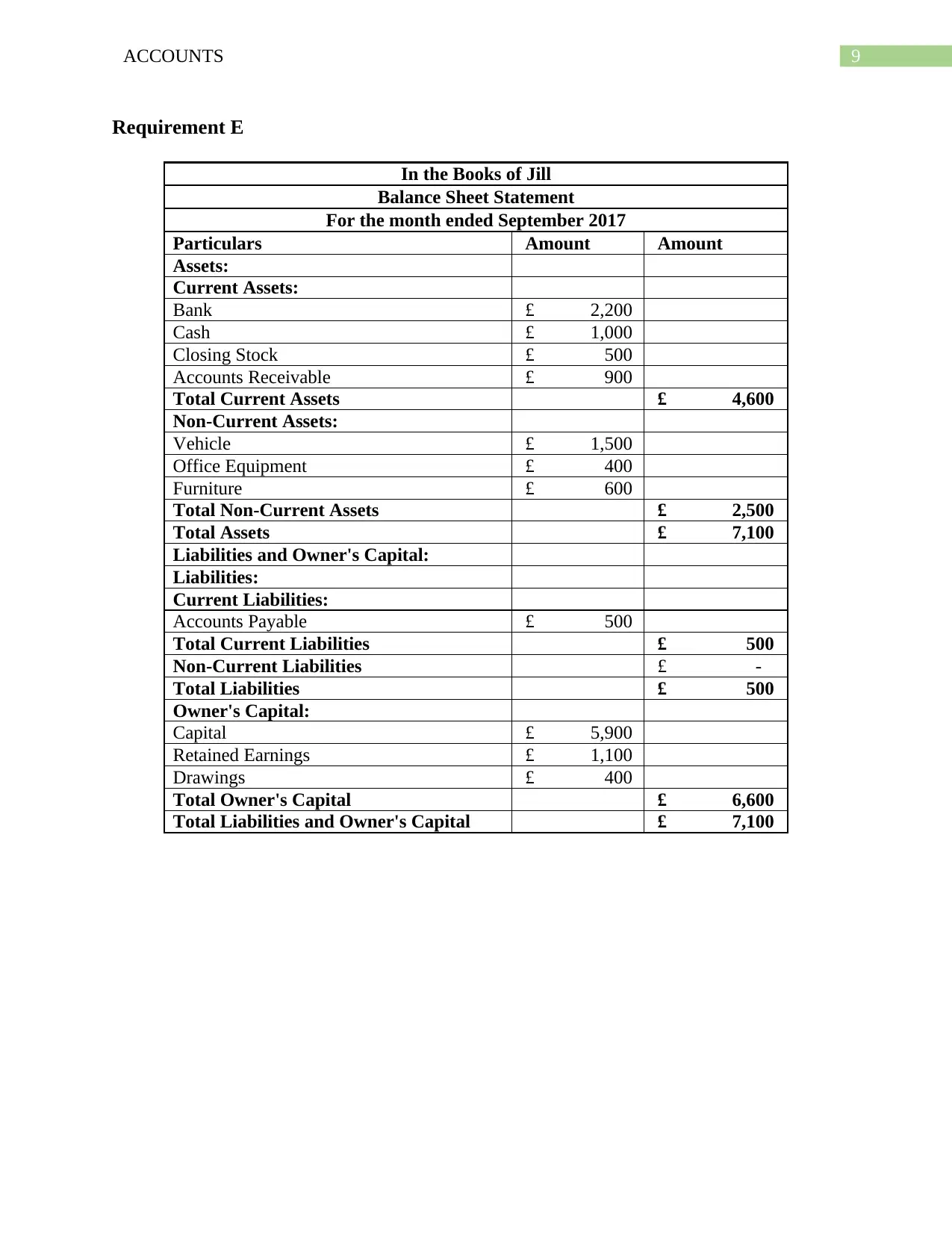
9ACCOUNTS
Requirement E
In the Books of Jill
Balance Sheet Statement
For the month ended September 2017
Particulars Amount Amount
Assets:
Current Assets:
Bank £ 2,200
Cash £ 1,000
Closing Stock £ 500
Accounts Receivable £ 900
Total Current Assets £ 4,600
Non-Current Assets:
Vehicle £ 1,500
Office Equipment £ 400
Furniture £ 600
Total Non-Current Assets £ 2,500
Total Assets £ 7,100
Liabilities and Owner's Capital:
Liabilities:
Current Liabilities:
Accounts Payable £ 500
Total Current Liabilities £ 500
Non-Current Liabilities £ -
Total Liabilities £ 500
Owner's Capital:
Capital £ 5,900
Retained Earnings £ 1,100
Drawings £ 400
Total Owner's Capital £ 6,600
Total Liabilities and Owner's Capital £ 7,100
Requirement E
In the Books of Jill
Balance Sheet Statement
For the month ended September 2017
Particulars Amount Amount
Assets:
Current Assets:
Bank £ 2,200
Cash £ 1,000
Closing Stock £ 500
Accounts Receivable £ 900
Total Current Assets £ 4,600
Non-Current Assets:
Vehicle £ 1,500
Office Equipment £ 400
Furniture £ 600
Total Non-Current Assets £ 2,500
Total Assets £ 7,100
Liabilities and Owner's Capital:
Liabilities:
Current Liabilities:
Accounts Payable £ 500
Total Current Liabilities £ 500
Non-Current Liabilities £ -
Total Liabilities £ 500
Owner's Capital:
Capital £ 5,900
Retained Earnings £ 1,100
Drawings £ 400
Total Owner's Capital £ 6,600
Total Liabilities and Owner's Capital £ 7,100
Paraphrase This Document
Need a fresh take? Get an instant paraphrase of this document with our AI Paraphraser

10ACCOUNTS
Part B
Ratio Analysis of Mel
Particulars Company
Net Profit 1100
Sales 3000
(Net Profit/Sales)
Net Profit Margin 37%
Gross Profit 2100
Sales 3000
(Gross Profit/Sales)
Gross Profit Margin 70%
Current Assets 4600
Current Liabilities 500
(Current Assets/Current Liabilities)
Current Ratio 9.2
Cash 1000
Bank 2200
Accounts Receivable 900
Current Liabilities 500
(Cash+ Bank+ Accounts Receivable/Current Liabilities)
Acid Test Ratio 8.2
Sales 3000
Accounts Receivables 900
(Sales/Accounts Receivable)
Accounts Receivable Turnover Ratio 3.33
Number of Days 365
Accounts Receivable Turnover Ratio 3.33
(365/ Accounts Receivable Turnover Ratio)
Average Collection Period 109.5
Accounts Payable 500
Cost of Sales 1400
Average Payment Period 130
Part B
Ratio Analysis of Mel
Particulars Company
Net Profit 1100
Sales 3000
(Net Profit/Sales)
Net Profit Margin 37%
Gross Profit 2100
Sales 3000
(Gross Profit/Sales)
Gross Profit Margin 70%
Current Assets 4600
Current Liabilities 500
(Current Assets/Current Liabilities)
Current Ratio 9.2
Cash 1000
Bank 2200
Accounts Receivable 900
Current Liabilities 500
(Cash+ Bank+ Accounts Receivable/Current Liabilities)
Acid Test Ratio 8.2
Sales 3000
Accounts Receivables 900
(Sales/Accounts Receivable)
Accounts Receivable Turnover Ratio 3.33
Number of Days 365
Accounts Receivable Turnover Ratio 3.33
(365/ Accounts Receivable Turnover Ratio)
Average Collection Period 109.5
Accounts Payable 500
Cost of Sales 1400
Average Payment Period 130
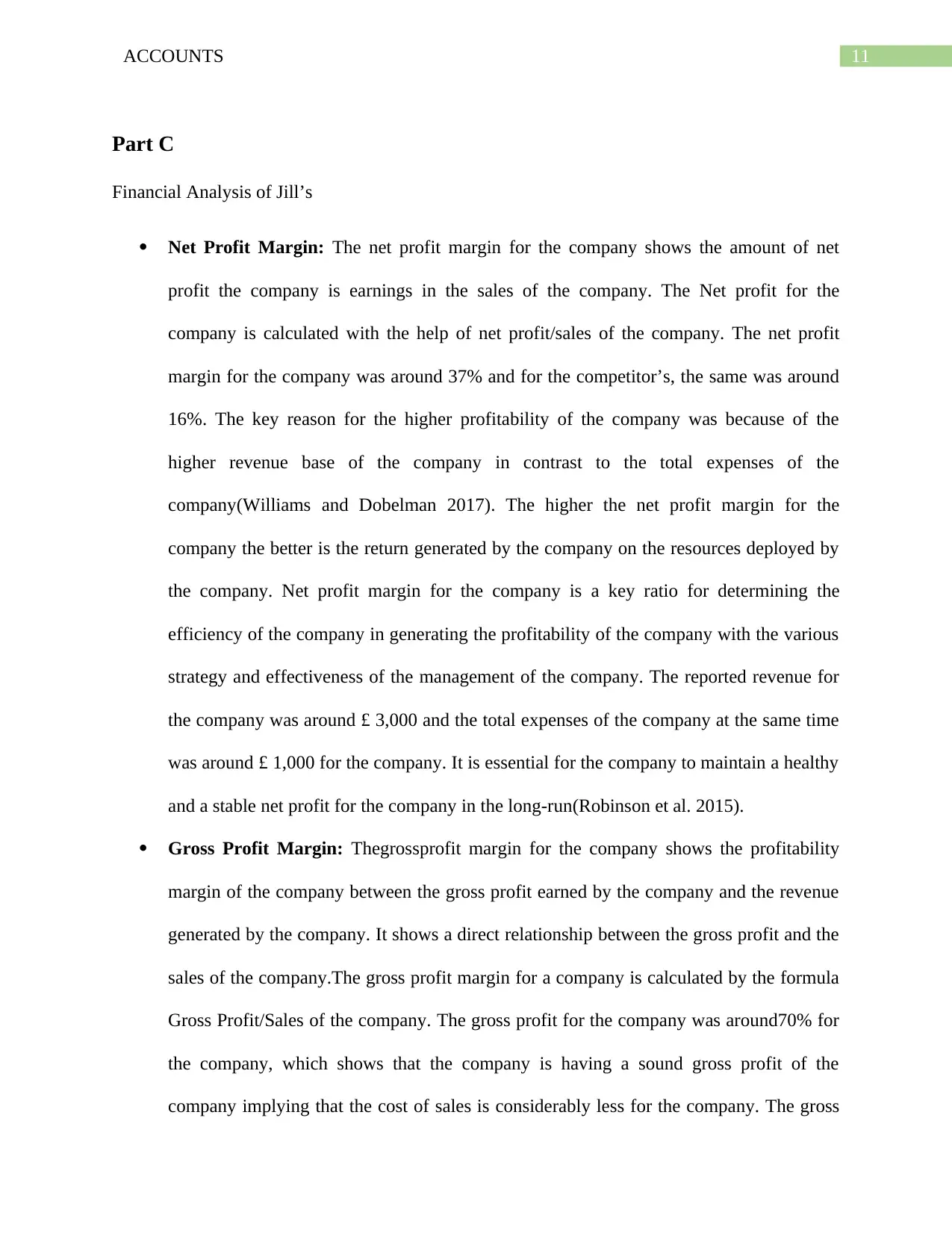
11ACCOUNTS
Part C
Financial Analysis of Jill’s
Net Profit Margin: The net profit margin for the company shows the amount of net
profit the company is earnings in the sales of the company. The Net profit for the
company is calculated with the help of net profit/sales of the company. The net profit
margin for the company was around 37% and for the competitor’s, the same was around
16%. The key reason for the higher profitability of the company was because of the
higher revenue base of the company in contrast to the total expenses of the
company(Williams and Dobelman 2017). The higher the net profit margin for the
company the better is the return generated by the company on the resources deployed by
the company. Net profit margin for the company is a key ratio for determining the
efficiency of the company in generating the profitability of the company with the various
strategy and effectiveness of the management of the company. The reported revenue for
the company was around £ 3,000 and the total expenses of the company at the same time
was around £ 1,000 for the company. It is essential for the company to maintain a healthy
and a stable net profit for the company in the long-run(Robinson et al. 2015).
Gross Profit Margin: Thegrossprofit margin for the company shows the profitability
margin of the company between the gross profit earned by the company and the revenue
generated by the company. It shows a direct relationship between the gross profit and the
sales of the company.The gross profit margin for a company is calculated by the formula
Gross Profit/Sales of the company. The gross profit for the company was around70% for
the company, which shows that the company is having a sound gross profit of the
company implying that the cost of sales is considerably less for the company. The gross
Part C
Financial Analysis of Jill’s
Net Profit Margin: The net profit margin for the company shows the amount of net
profit the company is earnings in the sales of the company. The Net profit for the
company is calculated with the help of net profit/sales of the company. The net profit
margin for the company was around 37% and for the competitor’s, the same was around
16%. The key reason for the higher profitability of the company was because of the
higher revenue base of the company in contrast to the total expenses of the
company(Williams and Dobelman 2017). The higher the net profit margin for the
company the better is the return generated by the company on the resources deployed by
the company. Net profit margin for the company is a key ratio for determining the
efficiency of the company in generating the profitability of the company with the various
strategy and effectiveness of the management of the company. The reported revenue for
the company was around £ 3,000 and the total expenses of the company at the same time
was around £ 1,000 for the company. It is essential for the company to maintain a healthy
and a stable net profit for the company in the long-run(Robinson et al. 2015).
Gross Profit Margin: Thegrossprofit margin for the company shows the profitability
margin of the company between the gross profit earned by the company and the revenue
generated by the company. It shows a direct relationship between the gross profit and the
sales of the company.The gross profit margin for a company is calculated by the formula
Gross Profit/Sales of the company. The gross profit for the company was around70% for
the company, which shows that the company is having a sound gross profit of the
company implying that the cost of sales is considerably less for the company. The gross
⊘ This is a preview!⊘
Do you want full access?
Subscribe today to unlock all pages.

Trusted by 1+ million students worldwide
1 out of 16
Related Documents
Your All-in-One AI-Powered Toolkit for Academic Success.
+13062052269
info@desklib.com
Available 24*7 on WhatsApp / Email
![[object Object]](/_next/static/media/star-bottom.7253800d.svg)
Unlock your academic potential
Copyright © 2020–2025 A2Z Services. All Rights Reserved. Developed and managed by ZUCOL.





